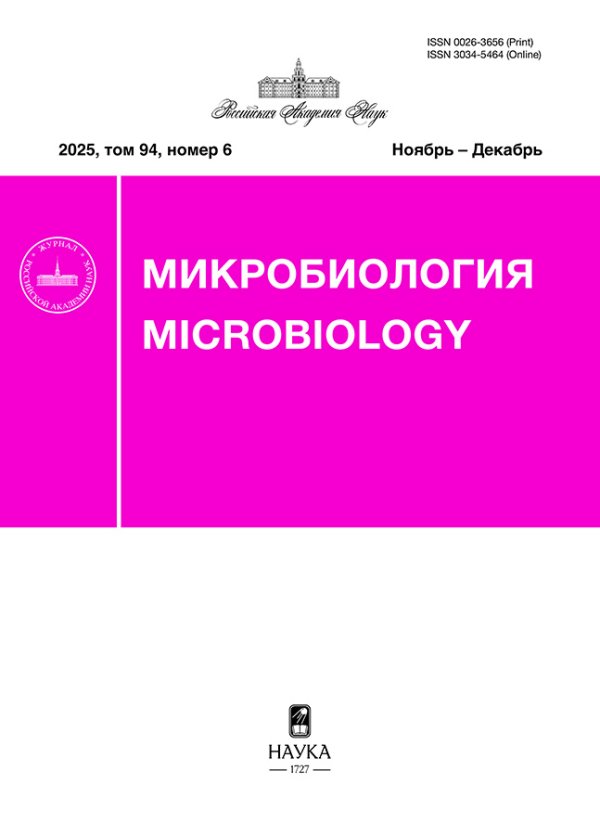Molecular Genetic and Functional Analysis of the Rap-Phr Signal System of the Plasmid pBS72 of Bacillus subtilis Isolates
- Authors: Gurinovich A.S.1, Titok M.A.1
-
Affiliations:
- Department of Microbiology, Belarusian State University
- Issue: Vol 92, No 5 (2023)
- Pages: 467-476
- Section: EXPERIMENTAL ARTICLES
- URL: https://journal-vniispk.ru/0026-3656/article/view/140507
- DOI: https://doi.org/10.31857/S0026365623600189
- EDN: https://elibrary.ru/KXAQMP
- ID: 140507
Cite item
Full Text
Abstract
Abstract—
The functional characteristics of the Rap-Phr quorum sensing signal system of the plasmid pBS72 were investigated. Phylogenetic relationship was revealed between Rap phosphatase coded by the plasmid pBS72 and the homologous polypeptides RapP and RapI determined by the plasmid pBS32 (68.4% identity) and the ICEBs1 conjugative transposon (36.9% identity). Similar to the phylogenetically related phosphatases, the studied Rap protein had a negative effect on sporulation. Unlike the known signal systems, Rap-Phr proteins were found to affect the viability of plasmid-bearing donor bacteria in the course of conjugative transfer of the plasmid pBS72 in the isogenic system. Impaired rap-phr genes resulted in a 10-fold decrease in the number of viable donor cells with the mutant plasmid after 3 and 4 h, and in a 100-fold decrease after 24 h. The number of formed transconjugants remained almost the same. Our results provide the basis for investigation of the mechanisms responsible for the effect of extrachromosomal genetic elements on the donor bacteria, providing for the propagation of the pBS72-like plasmids in natural environments.
About the authors
A. S. Gurinovich
Department of Microbiology, Belarusian State University
Author for correspondence.
Email: m_titok@bsu.by
Belarus, 220030, Minsk
M. A. Titok
Department of Microbiology, Belarusian State University
Author for correspondence.
Email: nastia.gurinovich96@gmail.com
Belarus, 220030, Minsk
References
- Гуринович А.С., Титок М.А. Молекулярно-генетический и функциональный анализ плазмиды pBS72 природных бактерий Bacillus subtilis // Микробиология. 2020. Т. 89. С. 646‒657.https://doi.org/10.31857/S0026365620060063
- Gurinovich A.S., Titok M.A. Molecular genetic and functional analysis of the pBS72 plasmid from Bacillus subtilis environmental isolates // Microbiology (Moscow). 2020. V. 89. P. 660–669.https://doi.org/10.1134/S0026261720060065
- Гуринович А.С., Титок М.А. Молекулярно-генетический и функциональный анализ системы конъюгации плазмиды pBS72 природных бактерий Bacillus subtilis // Microbiology (Moscow). 2022. V. 91. P. 451–465. https://doi.org/10.31857/S0026365622300188
- Gurinovich A.S., Titok M.A. Molecular genetic and functional analysis of the conjugation system of the pBS72 plasmid from Bacillus subtilis environmental isolates // Microbiology (Moscow). 2022. V. 91. № 4. P. 395–408.https://doi.org/10.1134/S002626172230018X
- Baker M.D., Neiditch M.B. Structural basis of response regulator inhibition by a bacterial anti-activator protein // PLoS Biol. 2011. V. 9. Art. e1001226. https://doi.org/10.1371/journal.pbio.1001226
- Beauregard P.B., Chai Y., Vlamakis H., Losick R., Kolter R. Bacillus subtilis biofilm induction by plant polysaccharides // Proc. Natl. Acad. Sci. USA. 2013. V. 110. P. 1621–1630. https://doi.org/10.1073/pnas.1218984110
- Belas R. When the swimming gets tough, the tough form a biofilm // Mol. Microbiol. 2013. V. 90. P. 1–5. https://doi.org/10.1111/mmi.12354
- Bendori S.O., Pollak S., Hizi D., Eldar A. The RapP‒PhrP quorum-sensing system of Bacillus subtilis strain NCIB3610 affects biofilm formation through multiple targets, due to an atypical signal-insensitive allele of RapP // J. Bacteriol. 2015. V. 197. P. 592–602.https://doi.org/10.1128/JB.02382-14
- Boguslawski K.M., Hill P.A., Griffith K.L. Novel mechanisms of controlling the activities of the transcription factors Spo0A and ComA by the plasmid-encoded quorum sensing regulators Rap60‒Phr60 in Bacillus subtilis // Mol. Microbiol. 2015. V. 96. P. 325–348. https://doi.org/10.1111/mmi.12939
- Branda S.S., Chu F., Kearns D.B., Losick R., Kolter R. A major protein component of the Bacillus subtilis biofilm matrix // Mol. Microbiol. 2006. V. 59. P. 1229–1238. https://doi.org/10.1111/j.1365-2958.2005.05020x
- Bullock W.O., Fernandez J.M., Short J.M. XL1-Blue: a high efficiency plasmid transforming recA Escherichia coli strain with beta-galactosidase selection // BioTechniques. 1987. V. 5. P. 376–378.
- Burton A.T., Kearns D.B. The large pBS32/pLS32 plasmid of ancestral Bacillus subtilis // J. Bacteriol. 2020. V. 202. Art. e00290-20.https://doi.org/10.1128/JB.00290-20
- Comella N., Grossman A.D. Conservation of genes and processes controlled by the quorum response in bacteria: characterization of genes controlled by the quorum-sensing transcription factor ComA in Bacillus subtilis // Mol. Microbiol. 2005. V. 57. P. 1159–1174. https://doi.org/10.1111/j.1365-2958.2005.04749x
- Erez Z., Steinberger-Levy I., Shamir M., Doron S., Stokar-Avihail A., Peleg Y., Melamed S., Leavitt A., Savidor A., Albeck S., Amitai G., Sorek R. Communication between viruses guides lysis-lysogeny decisions // Nature. 2017. V. 541. P. 488–493. https://doi.org/10.1038/nature21049
- Even-Tov E., Bendori S.O., Pollak S., Eldar A. Transient duplication dependent divergence and horizontal transfer underlie the evolutionary dynamics of bacterial cell–cell signaling // PLoS Biol. 2016. V. 14. Art. e2000330.https://doi.org/10.1371/journal.pbio.2000330
- Gallegos-Monterrosa R., Christensen M.N., Barchewitz T., Koppenhofer S., Priyadarshini B., Balint B., Maroti G., Kempen P.J., Dragos A., Kovacs A.T. Impact of Rap‒Phr system abundance on adaptation of Bacillus subtilis // Commun. Biol. 2021. V. 4. P. 468. https://doi.org/10.1038/s42003-021-01983-9
- Gastelum G., de la Torre M., Rocha J. Rap protein paralogs of Bacillus thuringiensis: a multifunctional and redundant regulatory repertoire for the control of collective functions // J. Bacteriol. 2020. V. 202. Art. e00747-19. https://doi.org/10.1128/JB.00747-19
- Gonzalez-Pastor J.E., Hobbs E.C., Losick R. Cannibalism by sporulating bacteria // Science (New York, N.Y.). 2003. V. 301. P. 510–513. https://doi.org/10.1126/science.1086462
- Harwood C.R., Mouillon J.M., Pohl S., Arnau J. Secondary metabolite production and the safety of industrially important members of the Bacillus subtilis group // FEMS Microbiol. Rev. 2018. V. 42. P. 721–738.https://doi.org/10.1093/femsre/fuy028
- Lopez D., Vlamakis H., Losick R., Kolter R. Cannibalism enhances biofilm development in Bacillus subtilis // Mol. Microbiol. 2009. V. 74. P. 609–618.https://doi.org/10.1111/j.1365-2958.2009.06882.x
- Mirouze N., Dubnau D. Chance and necessity in Bacillus subtilis development // Microbiol. Spectrum. 2013. V. 1. Art. TBS-0004-2012. https://doi.org/10.1128/microbiolspectrum.TBS-0004-2012
- Molecular Biological Methods for Bacillus / Eds. Harwood C.R., Cutting S.M. N.Y.: Chichester, 1991. P. 75–174.
- Neiditch M.B., Capodagli G.C., Prehna G., Federle M.J. Genetic and structural analyses of RRNPP intercellular peptide signaling of gram-positive bacteria // Annu. Rev. Genet. 2017. V. 51. P. 311–333.https://doi.org/10.1146/annurev-genet-120116-023507
- Parashar V., Konkol M.A., Kearns D.B., Neiditch M.B. A plasmid-encoded phosphatase regulates Bacillus subtilis biofilm architecture, sporulation, and genetic competence // J. Bacteriol. 2013. V. 195. P. 2437–2448.https://doi.org/10.1128/JB.02030-12
- Parashar V., Mirouze N., Dubnau D.A., Neiditch M.B. Structural basis of response regulator dephosphorylation by Rap phosphatases // PLoS Biol. 2011. V. 9. Art. e1000589.https://doi.org/10.1371/journal.pbio.1000589
- Rosch T.C., Golman W., Hucklesby L., Gonzalez-Pastor J.E., Graumann P.L. The presence of conjugative plasmid pLS20 affects global transcription of its Bacillus subtilis host and confers beneficial stress resistance to cells // Appl. Environ. Microbiol. 2014. V. 80. P. 1349–1358.https://doi.org/10.1128/AEM.03154-13
- Sambrook J., Fritsch E., Maniatis T. Molecular Cloning: A Laboratory Manual, 2nd ed. / Eds. Sambrook J., Fritsch E., Maniatis T. N.Y., Cold Spring Harbor: Cold Spring Harbor Laboratory Press, 1989. 468 p.
- Serra C.R., Earl A.M., Barbosa T.M., Kolter R., Henriques A.O. Sporulation during growth in a gut isolate of Bacillus subtilis // J. Bacteriol. 2014. V. 196. P. 4184–4196. https://doi.org/10.1128/JB.01993-14
- Singh P.K., Ramachandran G., Duran-Alcalde L., Alonso C., Wu L.J., Meijer W.J. Inhibition of Bacillus subtilis natural competence by a native, conjugative plasmid-encoded comK repressor protein // Environ. Microbiol. 2012. V. 14. P. 2812–2825.https://doi.org/10.1111/j.1462-2920.2012.02819x
- Singh P.K., Ramachandran G., Ramos-Ruiz R., Peiro-Pastor R., Abia D., Wu L.J., Meijer W.J. Mobility of the native Bacillus subtilis conjugative plasmid pLS20 is regulated by intercellular signaling // PLoS Genet. 2013. V. 9. Art. e1003892.https://doi.org/10.1371/journal.pgen.1003892
- te Riele H., Michel B., Ehrlich S.D. Single-stranded plasmid DNA in Bacillus subtilis and Staphylococcus aureus // Proc. Natl. Acad. Sci. USA. 1986. V. 83. P. 2541–2545.https://doi.org/10.1073/pnas.83.8.2541
- Verhamme D.T., Kiley T.B., Stanley-Wall N.R. DegU co-ordinates multicellular behaviour exhibited by Bacillus subtilis // Mol. Microbiol. 2007. V. 65. P. 554–568.https://doi.org/10.1111/j.1365-2958.2007.05810x
Supplementary files














